
This story includes spoilers for the season-four premiere of Black Mirror.
Black Mirror writer-creator Charlie Brooker has never met a twist ending he didn’t love. “USS Callister,” the feature-length season-four opener he co-wrote with William Bridges, relies on a blend of technological cynicism, grim moodiness, inventive science fiction, and a few twists in its closing moments, a structure that has become the template for many a Black Mirror episode. But it also has two distinct endings that help build toward its critique of the noxious, oft-violent aspects of white masculinity in fandom and the storied franchise it skewers.
First it’s important to understand the intersecting story lines of the episode. “USS Callister” begins as a blatant riff on the style and ethos of Star Trek: The Original Series. The chirps and sighs of the gadgets, the narrow-aspect ratio, softly lit interiors, candy-colored palette, technobabble, and mid-century Americana nods in the costuming make it immediately clear that Brooker is referencing TOS. The captain of the USS Callister, Robert Daly (Jesse Plemons), re-creates the staccato line readings and wry machismo that William Shatner used to launch Captain James T. Kirk into pop-culture fame back in the 1960s. But this isn’t real life. Daly is actually the disgruntled, socially awkward creator of an extremely popular virtual-reality game called Infinity who feels ignored by the women he’s drawn to and mistreated by his cocky co-creator James Walton (Jimmi Simpson).
Everything witnessed in the first few minutes is a secret, personalized patch of the Infinity game Daly created for himself, in which the adoring crew members are versions of his real-life co-workers. But these aren’t mere digital creations of Daly’s co-workers — they’re digital clones formed from DNA he swiped from coffee cups and other trash they left behind in the office. They’re sentient beings with all the memories of their real-life counterparts, up to the point where they were copied into the game, essentially trapped in order to be kissed, dressed, and tortured based on Daly’s whims. Making matters worse, they don’t have genitals. At all. The digital co-worker clones turned pawns — including the main bridge crew Shania Lowry (Michaela Coel playing a lovely rendition of Lt. Uhura from Star Trek), Elena Tulaska (Milanka Brooks), Nate Packer (Osy Ikhile), Kabir Dudani (Paul G. Raymond), and Walton — try to play by Daly’s rules in order to spare themselves the torture he gleefully and inventively doles out. But when Daly copies a new programmer, Nanette Cole (Cristin Milioti), the fragile dynamics of USS Callister are disrupted.
Despite the intelligence these people boast and the torture they’ve gone through, it’s Cole who inspires them to try to escape, devising a complex plan that relies on sending an SOS to her real-life counterpart. This initially backfires, and when Lowry tries to protect Cole from Daly’s wrath, he turns her into a hideous, alien monster. Daly revels in undermining and tormenting the crew, making the stakes of any mutiny exceedingly high. When you can’t die and have no control over your life, is mutiny worth it? Cole is undeterred, and after convincing the rest of the crew, she comes up with a new, far more complex plan.
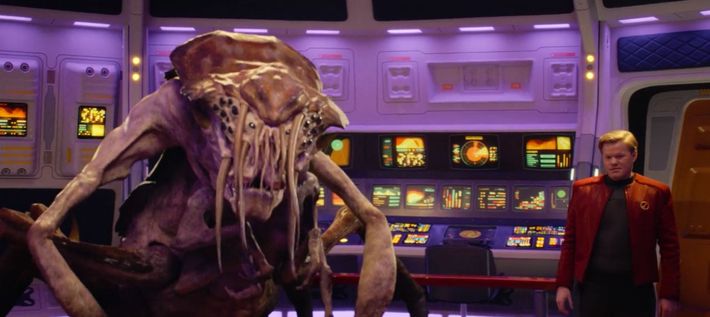
Here’s how it plays out in the end: Cole decides to blackmail her real-life counterpart using nude pictures she still has in her cloud. She pulls this off by presenting herself to Daly as the perfect science officer — eager to learn and even more eager to please. She comes up with a distress signal they investigate together on a remote planet. On the planet, Cole distracts Daly by seducing him to enter a calm lake with her. He gleefully assents, while at the same time aboard the USS Callister, Dudani beams the PDA device that helps Daly control the game to the bridge. Using it, they access Cole’s real-life cloud files, and they’re able to blackmail her into carrying out the rest of their plan.
Real-life Cole has a pizza ordered to Daly’s place, distracting him enough to pause the game, and sneaking into his apartment to swipe the DNA he has stored in his mini-fridge. By the time Daly returns to the game, Cole is gone. She’s back on USS Callister, heading full speed to the wormhole (a.k.a. the software update) in the hopes that entering it will effectively wipe them from existence. A furious Daly commandeers a downed spaceship in order to stop the USS Callister. Despite the considerable power Daly has shown throughout the episode within the game — turning wayward crew members into hideous monsters, erasing Cole’s facial features to suffocate her — he’s oddly unable to go fast enough to reach the USS Callister. The USS Callister is able to enter the wormhole, narrowly escaping Daly’s grasp.
The crew screams in agony as they vault through the wormhole. The screen goes black, but death isn’t apparently what’s in store for the reluctant members of the USS Callister. A bright white light followed with a lens flare that would make J.J. Abrams proud fills the screen. The team is intact, but not without a few changes. Gone is the white, bulky tech and brightly colored palette. Instead, the bridge of the USS Callister is sleek and chrome. They look more like themselves. No more blue-tinged skin, bouffant hair styles, or revealing clothing. Even better? They have their genitals. The Space Fleet mod has been stripped. They’re free and in the cloud, no longer trapped in Daly’s computer and the hellish game he created. Even the ship seems sleeker than it did under Daly’s watch. They’re also online, which we learn when they get an incoming transmission from a nearby ship that turns out to be a confrontational gamer (voiced by Aaron Paul).
Daly’s ending is exceedingly grim. He’s powerless and stuck floating in the game, screaming commands that no one will heed. In the real world, his body is limp, eyes white as his mind remains fixed in the virtual-reality hellscape of his own making. Considering it’s the holiday season and he’s a despicable person, we can’t expect that anyone will come over his apartment to save him from starving to death. Considering the depth of cruelty he imposed on others, this seems like a just fate. But even though the final moments of Cole and the crew of USS Callister are positioned as a triumphant achievement, allowing them to explore infinite space without the fascist rule of Daly controlling them, I have a few nagging questions.
• What happened to Jillian in marketing, who, when we first meet her, had already been turned into that grotesque alien monster? In explaining Jillian’s predicament to Cole, Lowry says, “This universe is littered with things like her … poor fuckers who stepped out of line.” So what happened to those poor souls? Were they wiped out of existence when the program was updated, or are they left like Daly, eternally trapped and screaming into the void? Thinking about what happened to people like Jillian somewhat undercuts the triumphant tone the final moments of the episode aim for.
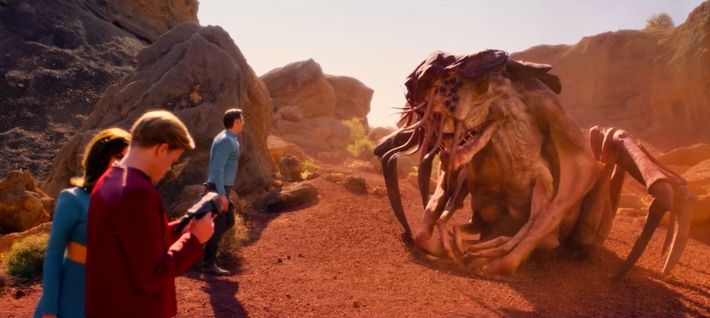
• Most curious to me, though, is the shift in costume and production design once they’ve gone through the wormhole. Here’s how they looked during most of the episode, an obvious allusion to Star Trek’s early years:
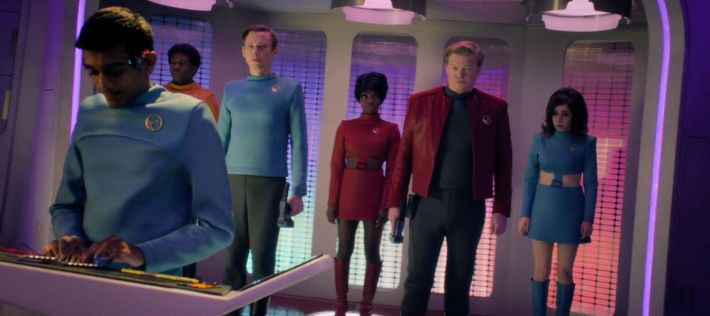
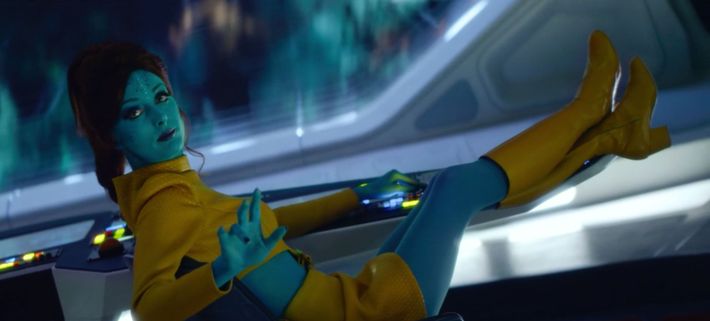
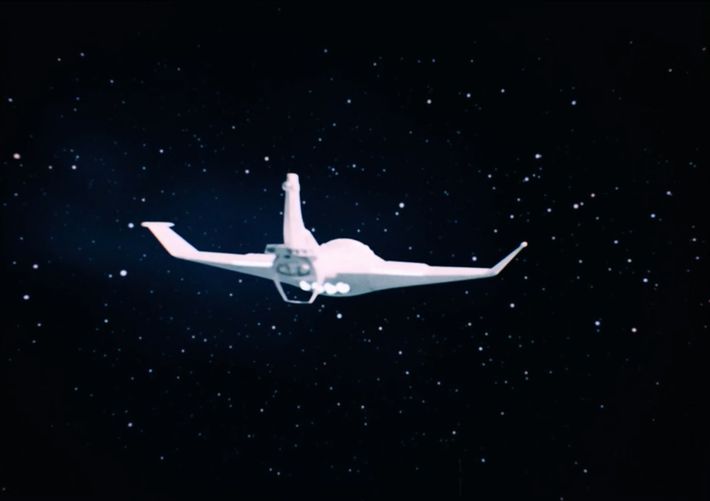
And this is how they look after going through the wormhole:
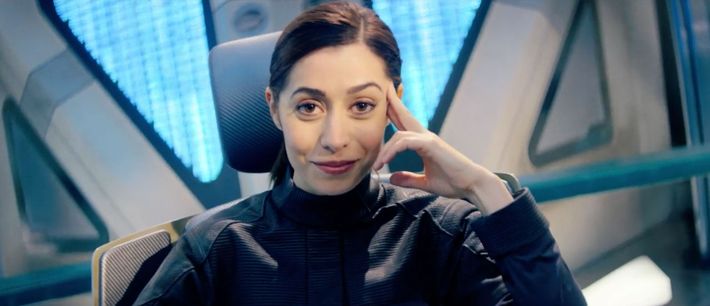
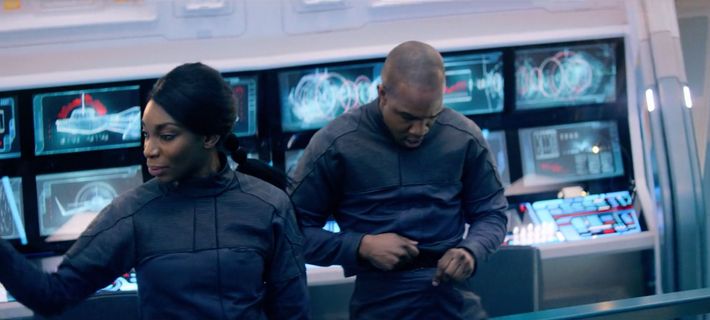

“USS Callister” skewers Star Trek as a means to discuss the ills of fandom and nerd culture. It’s also been one of the most praised and beloved episodes of the season. As Charles Bramesco wrote in the recap for Vulture, “‘USS Callister’ cements its status as one of the very best Black Mirror episodes when this crafty commentary improves upon the very sort of art it criticizes.” But I’m not sure it does, considering it wildly misunderstands what Star Trek: The Original Series meant at the time, the fans responsible for its lasting legacy, and the curious place it holds within pop culture today. The look of the USS Callister after the wormhole hews more toward the sleek, expansive vistas and streamlined costuming of more recent versions of Star Trek, which perhaps suggests that The Original Series has become an over-the-top curiosity in the wider cultural imagination, meant to be parodied, critiqued, and lambasted rather than using its ethos of diversity as a helpful tool for reckoning with pop culture. I’m cold on “USS Callister” due to its treatment of the Star Trek mythos and its predictability. But its two endings do open up fascinating and worthwhile conversations beyond Star Trek itself about fandom, the role of creators, toxic masculinity, and the hope of community. It’s also worthwhile to see Daly get the fate he deserves, trapped in a hell of his own making.
*This article has been updated to reflect the correct spelling of Charlie Brooker.


